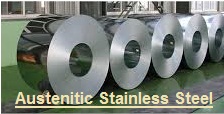6-Aug-2020
Low
Carbon Steel –
Composition of 0.05%-0.29% carbon and up to 0.4% manganese. They are the most
common form of steel commonly known as mild steel, a relatively low-cost
material, easy to shape (malleable). Low carbon steels provide material
properties that are acceptable for many applications.
Alloy Steel is an iron based mixture containing
manganese greater than 1.65%, silicon over 0.5%, copper above 0.6%, or other
minimum quantities of different alloying elements such as chromium, nickel,
molybdenum, or tungsten are present, each of which imparts different properties
to alloy steel. Alloy Steels are made by combining elements during the smelting
process when the iron is still molten. Chromium
is added in smaller amounts (0.5-2%) to increase hardenability and larger
amounts (4-18%) to increase corrosion resistance. Molybdenum is added in amounts of 0.25-0.40% to increase the
strength of the steel. Nickel is
added in smaller amounts (2-5%) to increase toughness and in larger amounts
(12-20%) to increase corrosion resistance. Silicon
is added to steel in smaller amounts (0.2-0.7%) to increase strength and in
larger amounts (>2%) to improve its magnetic properties while addition of Sulfur or Lead is done to increase the weldability.
The basic difference between stainless steel, conventional
alloy steel and carbon steel is that Stainless Steel contains a very high
percentage of chromium (11 – 26 percent) and nickel (3.5 – 22 percent).
Through
varying chromium content and by addition, substitution of other alloying
elements like nickel, molybdenum, copper, titanium, aluminium, silicon,
niobium, sulfur, selenium etc., resistance to corrosion, oxidation, abrasion,
hardness and a variety of other distinct properties are either created or
enhanced.
On the
other hand, steel that contains carbon up to about 1.7 percent as an essential
alloying constituent and has properties and structure made up mostly of the
element carbon is better known as Carbon
Steel. Most of the steel produced in the world is carbon steel. Unprotected
carbon steel rusts when exposed to air or moisture but stainless steel is
almost immune to rusting and ordinary corrosion.
WHAT IS CARBON STEEL
Carbon
steels are the base metals widely used in manufacturing in nearly every
industry, including aerospace, aircraft, automotive, chemical, defense, and
precision. Carbon steel’s strength is due to its crystalline structure. Groups
of iron and carbon atoms are arranged in a lattice, with the carbon atoms
preventing the iron atoms from slipping over each other, which imparts the
steel more rigidity.
The
addition of an alloy such as titanium or manganese strengthens this structure
by adding different atomic sizes to the lattice. This reinforces steel's
rigidity by further impeding molecular movement when the metal is subjected to
stresses. There are four types of carbon steel based on the amount of carbon
present in the alloy.
 |
| Stainless Steel Pipes, Board, Kitchen |
Medium
Carbon Steel –
Composition of 0.29%-0.54% carbon, with 0.60%-1.65% manganese. Medium carbon
steel is ductile, strong and has good wear resistance. Because of the above
properties, they find use in forging, heavy industries, and automotive
components.
High
Carbon Steel –
Composition of 0.55%-0.99% carbon, with 0.30%-0.90% manganese. It is very
strong and holds shape memory well, making it ideal for springs and high-strength
wires.
Ultra
High or Very High Carbon Steel
- Composition of 1%-2.1% carbon. Its high carbon content makes it an extremely
strong material. Due to its brittleness, this grade requires special handling.
However, ultra high carbon steels can be tempered to great hardness and are
used for specialized products such as knives, axles etc. Tighter carbon content
control for more consistent heat treatment. Steels with carbon content above 2%
are considered to be cast iron.
WHAT IS ALLOY STEEL
 |
| Stainless Steel utilities |
WHAT IS STAINLESS STEEL
Stainless
steel is an alloy developed in the early 1900’s after metallurgists discovered
that chromium added iron alloys displayed superior corrosion resistance to
carbon steel alloys. The first products using stainless steel were produced in
1908 and the first patents were granted in 1912.
Stainless
Steel is a highly durable alloy containing the following major ingredients:
- 10 - 30 per cent of chromium by mass giving
excellent corrosion and oxidation resistance to it.
- Rest about more than 50 percent iron.
The
corrosion resistance that is unique to stainless steel is the result of a
transparent passive film of chromium oxide forms on the surface of the steel
and protects it from oxidation. Higher chromium levels increase the corrosion
resistance of the steel, but it creases the brittleness of the metal, making it
hard to work with. There are different categories and types stainless steels.
To know more please refer to -
- Categories
and Types of Stainless Steel: Compositions and Properties
- Grades
and Series of Stainless Steel - Compositions and Uses








